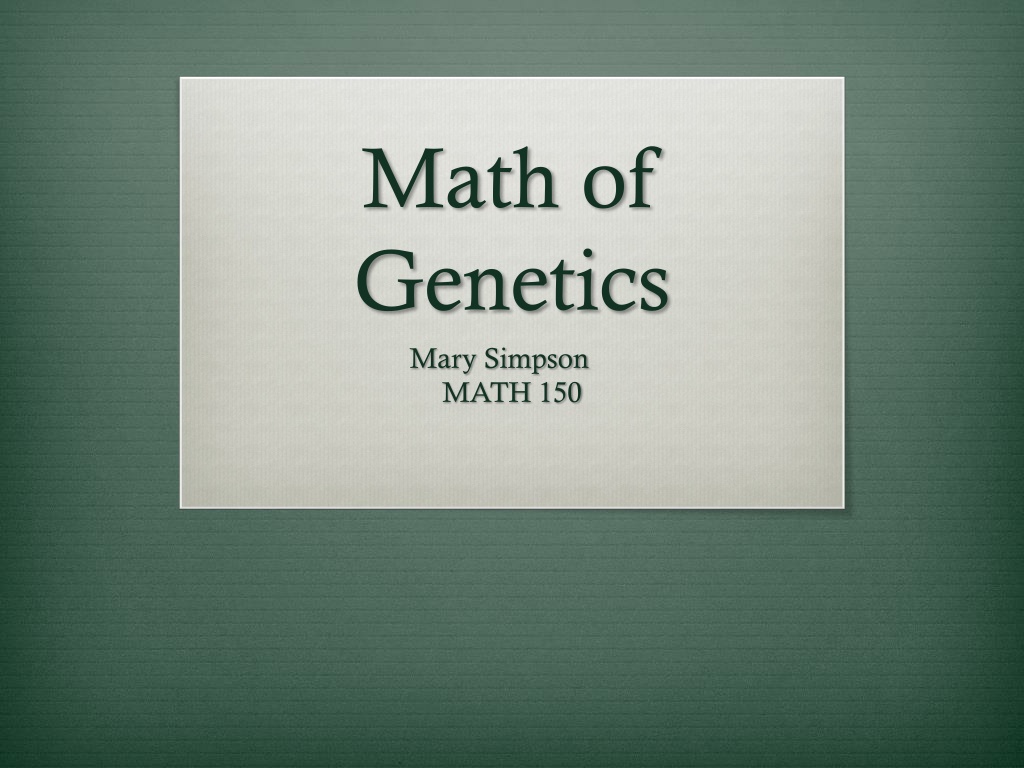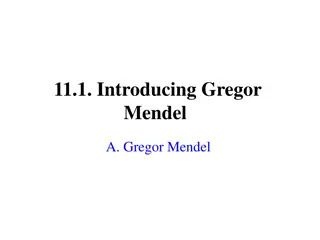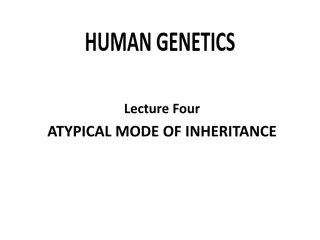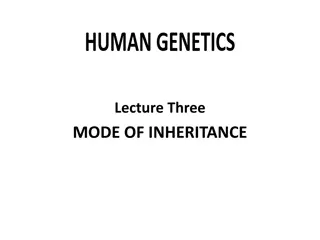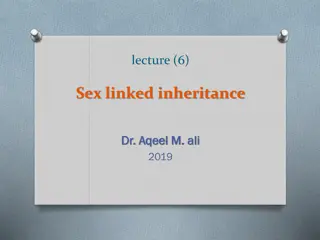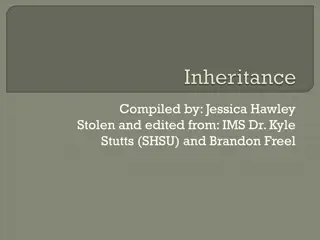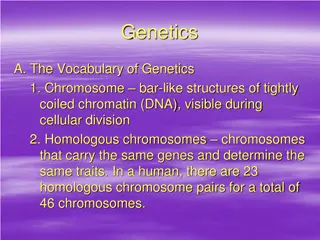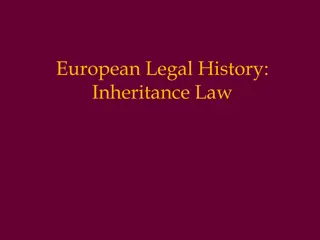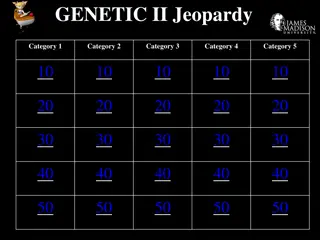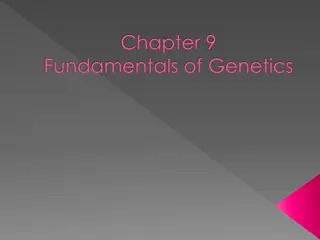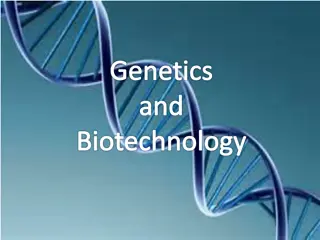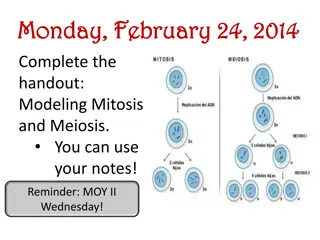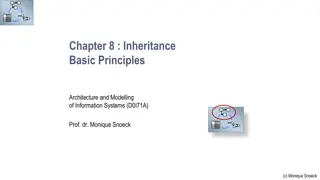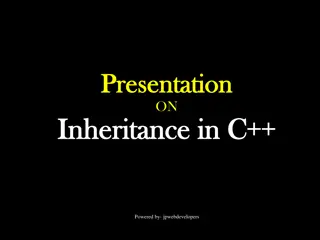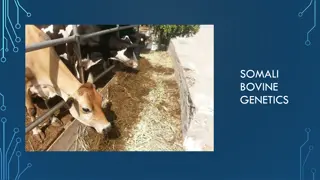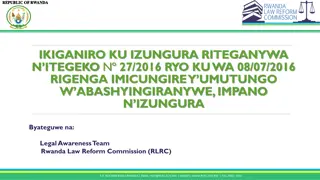Exploring the Basics of Genetics and Inheritance
Understanding the fundamentals of genetics and inheritance, this content covers topics such as Mendelian genetics, gene inheritance, chromosomes, alleles, and Gregor Mendel's pioneering work. It delves into genetic outcomes related to multiple traits, linkage, dominance, Hardy-Weinberg equations, and more, providing a flashback to high school biology while exploring how genes are inherited through chromosomes.
Download Presentation

Please find below an Image/Link to download the presentation.
The content on the website is provided AS IS for your information and personal use only. It may not be sold, licensed, or shared on other websites without obtaining consent from the author. Download presentation by click this link. If you encounter any issues during the download, it is possible that the publisher has removed the file from their server.
E N D
Presentation Transcript
Math of Genetics Mary Simpson MATH 150
Objectives Understanding how to find the probability of genetic outcomes for situations involving: Multiple Traits Linkage Incomplete Dominance Codominance Multiple Allelism Understanding Hardy Weinberg Equations in relation to population genetics
Flashback to High School Biology! Genetics: the study of the inheritance of traits Gene: a section of DNA that influences the heredity of a trait
Flashback to High School Biology! Genetics: the study of the inheritance of traits Gene: a section of DNA that influences the heredity of a trait Chromosome: dense coils of DNA that contain multiple genes Allele: denotes different versions of the same gene
Flashback to High School Biology! Genetics: the study of the inheritance of traits Gene: a section of DNA that influences the heredity of a trait Chromosome: dense coils of DNA that contain multiple genes Allele: denotes different versions of the same gene Gregor Mendel was a pioneer in genetics
Mendelian Genetics Gregor Mendel (1822- 1884) Studied the inheritance of traits in pea plants
Mendelian Genetics Gregor Mendel (1822- 1884) Studied the inheritance of traits in pea plants Mendel looked for patterns in the inheritance traits from parents with specified traits
How Genes Are Inherited The average human had 46 chromosomes (2 sets of 23)
How Genes Are Inherited The average human had 46 chromosomes (2 sets of 23) Half of these chromosomes come from the mother and half from the father (1 set from each parent)
How Genes Are Inherited The average human had 46 chromosomes (2 sets of 23) Half of these chromosomes come from the mother and half from the father (1 set from each parent) Because there are two sets of chromosomes, a person inherits two copies of each gene
How Genes Are Inherited The average human had 46 chromosomes (2 sets of 23) Half of these chromosomes come from the mother and half from the father (1 set from each parent) Because there are two sets of chromosomes, a person inherits two copies of each gene A person has two alleles for each trait that interact, resulting in the expressed trait
Inheritance of Single Traits Dominant Trait: if a gene for the dominant trait (called a dominant allele) is present, it will be expressed Usually expressed with an uppercase letter (ex. A) Recessive Trait: this trait will only be expressed in the absence of a dominant allele Usually expressed with a lowercase letter (ex. a)
Inheritance of Single Traits Dominant Trait: if a gene for the dominant trait (called a dominant allele) is present, it will be expressed Usually expressed with an uppercase letter (ex. A) Recessive Trait: this trait will only be expressed in the absence of a dominant allele Usually expressed with a lowercase letter (ex. a) Genotype: the combination of two alleles (ex. Aa) Phenotype: the trait expression that results from a genotype
Inheritance of Single Traits Dominant Trait: if a gene for the dominant trait (called a dominant allele) is present, it will be expressed Usually expressed with an uppercase letter (ex. A) Recessive Trait: this trait will only be expressed in the absence of a dominant allele Usually expressed with a lowercase letter (ex. a) Genotype: the combination of two alleles (ex. Aa) Phenotype: the trait expression that results from a genotype Homozygous: genotype with two copies of the same allele (ex. AA, aa) Heterozygous: genotype with one dominant allele and one recessive allele (ex. Aa)
Punnett Squares To form a punnett square, form a grid with the paternal genotype on the top and the maternal genotype down the left side
Punnett Squares To form a punnett square, form a grid with the paternal genotype on the top and the maternal genotype down the left side In the center sections of the table, combine the paternal and maternal alleles to create all possible genotypes for the offspring
Punnett Square Example If we have a mother with genotype aa and a father with genotype Aa The punnett square would look as follows: a a A a
Punnett Square Example If we have a mother with genotype aa and a father with genotype Aa The punnett square would look as follows: a a A A A a a a
Punnett Square Example If we have a mother with genotype aa and a father with genotype Aa The punnett square would look as follows: a a A Aa Aa a aa aa
Punnett Square Example If we have a mother with genotype aa and a father with genotype Aa The punnett square would look as follows: Genotypic Ratio: a ratio of the number of possible outcomes of each genotype (in this example 1:1) Phenotypic Ratio: ratio of the number of outcomes that will result in different phenotypes (in this example 1:1) a a A Aa Aa a aa aa
Practice Problem The allele for dark hair (B) is dominant and the allele for light hair (b) is recessive If a female with genotype Bb and a male with genotype Bb mate, what are the chances that they will have a light haired offspring?
Practice Problem The allele for dark hair (B) is dominant and the allele for light hair (b) is recessive If a female with genotype Bb and a male with genotype Bb mate, what are the chances that they will have a light haired offspring? B b B b
Practice Problem The allele for dark hair (B) is dominant and the allele for light hair (b) is recessive If a female with genotype Bb and a male with genotype Bb mate, what are the chances that they will have a light haired offspring? B b B B B b b b
Practice Problem The allele for dark hair (B) is dominant and the allele for light hair (b) is recessive If a female with genotype Bb and a male with genotype Bb mate, what are the chances that they will have a light haired offspring? B b B BB Bb b Bb bb
Practice Problem The allele for dark hair (B) is dominant and the allele for light hair (b) is recessive If a female with genotype Bb and a male with genotype Bb mate, what are the chances that they will have a light haired offspring? To have light hair the genotype must be bb B b There is only a 1/4 chance of that, therefore the chance is 25% B BB Bb b Bb bb
Inheritance of Two Traits Looking at the inheritance of two traits is called a dihybrid cross
Inheritance of Two Traits Looking at the inheritance of two traits is called a dihybrid cross To set up the punnett square you have to look at all possible combinations of maternal and paternal DNA
Inheritance of Two Traits Looking at the inheritance of two traits is called a dihybrid cross To set up the punnett square you have to look at all possible combinations of maternal and paternal DNA You use those 4 combinations from each parent to set up the punnett square
Practice Problem We will look at the inheritance of brown and black fur and coarse and soft fur in hamsters Brown fur (B) and soft fur (S) are dominant
Practice Problem We will look at the inheritance of brown and black fur and coarse and soft fur in hamsters Brown fur (B) and soft fur (S) are dominant
Practice Problem We will look at the inheritance of brown and black fur and coarse and soft fur in hamsters Brown fur (B) and soft fur (S) are dominant If the mother has genotype BBss and the father has genotype BbSs, what is the chance that an offspring will have brown coarse fur?
Practice Problem Cont. If the mother has genotype Bbss and the father has genotype BbSs, what is the chance that an offspring will have brown coarse fur? BS Bs bS bs Bs Bs bs bs
Practice Problem Cont. If the mother has genotype Bbss and the father has genotype BbSs, what is the chance that an offspring will have brown coarse fur? BS Bs bS bs Bs Bs Bs Bs Bs Bs Bs Bs Bs Bs bs bs bs bs bs bs bs bs bs bs
Practice Problem Cont. If the mother has genotype Bbss and the father has genotype BbSs, what is the chance that an offspring will have brown coarse fur? BS Bs bS bs Bs BBSs BBss BbSs Bbss Bs BBSs BBss BbSs Bbss bs bBSs bBss bbSs bbss bs bBSs bBss bbSs bbss
Practice Problem Cont. If the mother has genotype Bbss and the father has genotype BbSs, what is the chance that an offspring will have brown coarse fur? BS Bs bS bs Bs BBSs BBss BbSs Bbss Bs BBSs BBss BbSs Bbss bs bBSs bBss bbSs bbss bs bBSs bBss bbSs bbss Phenotypic Ratio 6:6:2:2
Practice Problem Cont. If the mother has genotype Bbss and the father has genotype BbSs, what is the chance that an offspring will have brown coarse fur? BS Bs bS bs Bs BBSs BBss BbSs Bbss Bs BBSs BBss BbSs Bbss bs bBSs bBss bbSs bbss bs bBSs bBss bbSs bbss Phenotypic Ratio 6:6:2:2
Practice Problem Cont. If the mother has genotype Bbss and the father has genotype BbSs, what is the chance that an offspring will have brown coarse fur? BS Bs bS bs Bs BBSs BBss BbSs Bbss Bs BBSs BBss BbSs Bbss bs bBSs bBss bbSs bbss bs bBSs bBss bbSs bbss Phenotypic Ratio 6:6:2:2 Out of the sixteen possible genetic combinations, 6 result in brown, coarse fur 6/16= .375 = 37.5%
Linkage Linked genes are those found on the same chromosome
Linkage Linked genes are those found on the same chromosome This means that these traits should not follow the same pattern of inheritance because the traits cannot be independently assorted into gametes
Linkage Linked genes are those found on the same chromosome This means that these traits should not follow the same pattern of inheritance because the traits cannot be independently assorted into gametes In terms of a punnett square, having two linked traits would be treated like having a single trait
Linkage Linked genes are those found on the same chromosome This means that these traits should not follow the same pattern of inheritance because the traits cannot be independently assorted into gametes In terms of a punnett square, having two linked traits would be treated like having a single trait Mendel was lucky that each of the traits he studied had genes that were not linked
Incomplete Dominance Incomplete dominance means that the dominant allele will not completely dominant the recessive allele
Incomplete Dominance Incomplete dominance means that the dominant allele will not completely dominant the recessive allele In many cases this means that heterozygous individuals will have intermediate phenotypes
Incomplete Dominance Incomplete dominance means that the dominant allele will not completely dominant the recessive allele In many cases this means that heterozygous individuals will have intermediate phenotypes This will not alter genotypic ratios, but it will alter phenotypic ratios
Practice Problem The allele for white flowers (R) is dominant, but it s dominance incomplete The allele for red flowers (r) is recessive
Practice Problem The allele for white flowers (R) is dominant, but it s dominance incomplete The allele for red flowers (r) is recessive What are the possible phenotypes of the offspring of two plants with genotypes Rr and Rr?
Practice Problem The allele for white flowers (R) is dominant, but it s dominance incomplete The allele for red flowers (r) is recessive What are the possible phenotypes of the offspring of two plants with genotypes Rr and Rr? R r R r
Practice Problem The allele for white flowers (R) is dominant, but it s dominance incomplete The allele for red flowers (r) is recessive What are the possible phenotypes of the offspring of two plants with genotypes Rr and Rr? R RR r Rr R r Rr rr
Practice Problem The allele for white flowers (R) is dominant, but it s dominance incomplete The allele for red flowers (r) is recessive What are the possible phenotypes of the offspring of two plants with genotypes Rr and Rr? RR will have white flowers rr will have red flowers Rr will have pink flowers (intermediate between white and red) R RR r Rr R r Rr rr
Practice Problem If we mated two of that same type of flowers with the genotypes, RR and Rr, what is the probability that the offspring will have pink flowers?
